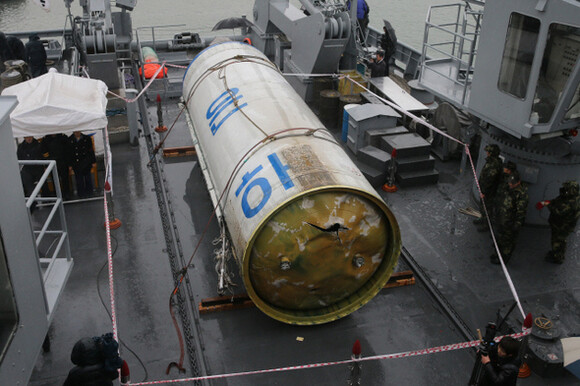hankyoreh
Links to other country sites 다른 나라 사이트 링크
Most of December rocket was produced within North Korea

By Kim Kyu-won, staff reporter
The second Unha-3 rocket, which was launched by North Korea on Dec. 12, 2012, used six to ten parts that were commonly available from China and four other countries, reports say. However, analysts believe that the majority of the parts were manufactured inside North Korea.
According to an analysis released on Jan. 21 by the Agency for Defense Development (ADD), which is affiliated with the Ministry of National Defense, the debris of the Unha-3 that was retrieved from the West (Yellow) Sea included 6-10 foreign parts. The majority was made in North Korea.
The parts manufactured overseas were DC converters, temperature sensors and a number of other electronic devices. All of them were products made for everyday use. Aside from these, the rest of the parts were confirmed to have been manufactured directly by North Korea.
The Ministry of National Defense announced that the foreign parts had been manufactured in five countries that were not named due to diplomatic considerations. China was one of the five countries, reports say.
“The foreign parts would have been easy to buy, even by someone who was traveling,” explained a source at ADD. Consequently, it appears unlikely that North Korea smuggled in these parts, as was suggested by certain groups.
A source at the Ministry said much the same thing. “The foreign-manufactured parts are not included in the items that are restricted by United Nations Security Council (UNSC) Resolution 1874, which was passed in 2009, or the Missile Technology Control Regime (MTCR).”
Despite this, the Ministry said that the UNSC might reexamine how North Korea purchased these parts.
“If any of the companies that produced the foreign parts that were used in the Unha-3 rocket have dealings with North Korea or with companies affiliated with that country, it could become a problem,” a Ministry source said. “We are planning to report the findings of our investigation to the UNSC, and we will also send them to the MTCR if they request it.”
North Korea’s Unha-3 rocket makes use of a different kind of technology than South Korea’s Naro space launch vehicle, ADD analysts found. The Naro has two boosters, while the Unha-3 has three.
The two rockets’ steering methods are also different. On the Naro, the entire engine is able to move, but on the Unha-3, the main engine is fixed in place, with four supplementary engines rotating to change direction. Additionally, the surface of South Korea’s rocket is smooth, while the North Korean rocket’s coating is rough.
In the case of the engine, the key rocket component, North Korea used Rodong missile technology from the 1990s. This is for the most part similar to Iran’s missile technology and different from China’s long-range nuclear missile, the Dong Feng 31, ADD staff explained.
A source at the ADD offered the following assessment. “Notwithstanding restrictions on the introduction of technology and the acquisition of parts through sanctions by the international community, the North was able to improve the quality of its long-range missile technology through many experiments.”
Please direct questions or comments to [english@hani.co.kr]

Editorial・opinion
![[Column] Park Geun-hye déjà vu in Yoon Suk-yeol [Column] Park Geun-hye déjà vu in Yoon Suk-yeol](https://flexible.img.hani.co.kr/flexible/normal/500/300/imgdb/original/2024/0424/651713945113788.jpg) [Column] Park Geun-hye déjà vu in Yoon Suk-yeol
[Column] Park Geun-hye déjà vu in Yoon Suk-yeol![[Editorial] New weight of N. Korea’s nuclear threats makes dialogue all the more urgent [Editorial] New weight of N. Korea’s nuclear threats makes dialogue all the more urgent](https://flexible.img.hani.co.kr/flexible/normal/500/300/imgdb/original/2024/0424/7317139454662664.jpg) [Editorial] New weight of N. Korea’s nuclear threats makes dialogue all the more urgent
[Editorial] New weight of N. Korea’s nuclear threats makes dialogue all the more urgent- [Guest essay] The real reason Korea’s new right wants to dub Rhee a founding father
- [Column] ‘Choson’: Is it time we start referring to N. Korea in its own terms?
- [Editorial] Japan’s rewriting of history with Korea has gone too far
- [Column] The president’s questionable capacity for dialogue
- [Column] Are chaebol firms just pizza pies for families to divvy up as they please?
- [Column] Has Korea, too, crossed the Rubicon on China?
- [Correspondent’s column] In Japan’s alliance with US, echoes of its past alliances with UK
- [Editorial] Does Yoon think the Korean public is wrong?
Most viewed articles
- 1‘We must say no’: Seoul defense chief on Korean, USFK involvement in hypothetical Taiwan crisis
- 2N. Korean delegation’s trip to Iran shows how Pyongyang is leveraging ties with Moscow
- 3‘Weddingflation’ breaks the bank for Korean couples-to-be
- 4Korea sees more deaths than births for 52nd consecutive month in February
- 546% of cases of violence against women in Korea perpetrated by intimate partner, study finds
- 6[Column] Park Geun-hye déjà vu in Yoon Suk-yeol
- 7Will NewJeans end up collateral damage in internal feud at K-pop juggernaut Hybe?
- 8Amnesty notes ‘erosion’ of freedom of expression in Korea in annual human rights report
- 9[Editorial] New weight of N. Korea’s nuclear threats makes dialogue all the more urgent
- 10[Column] Yoon’s first 100 days should open our eyes to pitfalls of presidential system